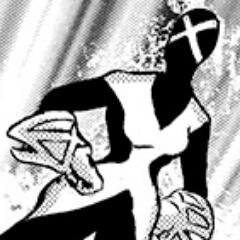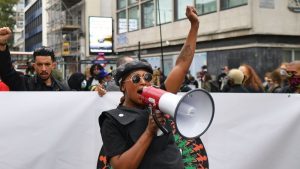
Carrying my bike up the stairs from the BART station straight into Oscar Grant Plaza (formerly Frank Ogawa), the very first scene I came upon was a highly charged, three to four-hundred person General Assembly. Not having seen with my own eyes the mass marches complete with angry chanting, bottle–throwing, window-smashing, and frustrated pacifists (always a funny sight), I was (to say the least) stunned. There were pockets of people lumped together in side debates while many individuals were aching to get on the human mic and shout out their condemnation of any “acts of violence” with others advocated respect for “diversity of tactics.” People gave impassioned and moving speeches as if convincing the crowd was a life or death matter.
Though I lacked experience as an activist, philosophy and critical theory prepared me for this great argument which played a crucial role in forming Occupy Oakland: the question of violence. The work of certain philosophers, most notably Simon Critchley, can help elucidate the problem of non-violent resistance along with making finite vs. infinite demands. I’ve come to accept ‘diversity of tactics’ as an important principle for avoiding the co-option and disintegration of Occupy Oakland. I believe it is primarily diversity of tactics and pin-pointing the police as an enemy, along with eschewing demands and leaders common to other occupies, that has kept Occupy Oakland resilient and adaptive.
Critchley often characterizes himself as a “neo-anarchist” philosopher and works extensively on the body of thought relating to utopia, critical resistance, and ethical demands. As a weak, marginalized force living under the rule of economy-controlling elites, making demands towards players within the dominant political system one is subjected to or opting for more justice than such a system can provide is a complex issue. Demanding too little or too much could derail any chance at effectively altering an intolerable situation. Making a multitude of infinite demands – transcending local conditions – has the ability to change the very terrain of the situation, as long as the local aspects are not forgotten entirely. Similarly, condemning violence, on the surface a worthy proposition, could limit the groups actions considering its a universally binding principle on the actions of individuals in a local context.
I maintain that it is the demands that ought to be infinite and so transcend the local, while the consensual agreements by members of this local group ought to be fluid and finite. This distinction will help create a distance between the standard political bind where state-based ethics, due to the universally binding and cold external laws, are ”externally binding, but not internally compelling” (ID, 7). The opposite must be encased by occupies for them to ”be the change we wish to see in the world”, as it goes: the ethical imperative must be compelling and righteous going beyond the local emergent community, while the rules and proposals the General Assembly passes should be taken lightly and without any hint of police-style enforcement.
My interpretation of Critchley’s thought will center around connecting both recent and timeless philosophical debates with the urgent and very much ongoing occupy protests, with a local focus on Occupy Oakland. My fascination and attachment to Occupy Oakland stems largely from our commitment to rejecting all potential threats of co-option – a recurring theme in critical theory and philosophy. A pairing of these two worlds, occupations in public spaces of inner cities and dense academic theory, can lead to a mutual vitalization making philosophy relevant again and keeping the occupy movement radical. I claim that the driving force of this ”indefinite protest” (in two senses) is its local-territorial nature pertaining to the defendable encampments and the subject-forming name ’occupy’, both of which give this emergent community its ethical-political attraction.
Facing a swelling of large corporate manipulation of public government and the inability of one to check the other, the call for a radical politics that is not immediately accommodated by the powers that be has taken on a radical ethical dimension moving people to protest indefinitely. The forces of the state and the financial institutions have grown so large and wedded to each other that enforcing accountability (moral hazard) leads to the potential for total structural collapse. This is at least the story that is perpetuated in the media and by the ”experts”: ‘too big to fail’ – though whether all our societal relationships would suddenly collapse if the rules applied to all citizens including those at the top of the pyramid is unclear. Perhaps we simply cannot imagine an economy that doesn’t function as the one today does.
If we are to imagine a future not tainted by apocalyptic visions, a wholly different kind of politics is required which avoids the perils of “state or market” language. The political options which seem viable and realistic for fighting dominant powers (e.g. reforms, electing new candidates, etc.) are circumvented into existing political bodies held hostage by large corporations and banks – the ones which are the cause of this whole mess. These bodies, ever-hungry for more profits, have accumulated so much money and have such a giant (visible) hand in the relations between people, that governmental bodies cannot prosecute their fraudulent, environment-ruining, parasitic (you get the idea) behavior. Doing so would bring a dramatic restructuring of economy and society which many desire but would challenge the means by which members of the elite maintain their power. Its a vicious cycle that drains wealth and value from a vast majority of the population while the wheel keeps spinning. And so we have reached a bind where a struggle is inevitable and revolutionary ideas find new contexts in which to be articulated.
A resurgence in utopian thinking has emerged that need not be limited to a theoretical analysis of blank slate, state of nature societies, which tend to go straight to the top and restructure the corrupt world of the present according to a theory. The experience of the 20th century fresh in our memory, utopian thinking has such a stigma attached to it that we forget that we are living in a present dominated by a utopian vision: Capitalism. “The various anti-capitalist experiments in communal living and collective existence…”, as Critchley points out in his Faith of the Faithless lecture, “seem to us either quaintly passé [or] laughably unrealistic”. Often public rage fueled by fantastical dreams of other worlds are swept away as childish and infantile, distracting from real-world politics, as Oakland Mayor Jean Quan and others have repeatedly remarked of Occupy Oakland. Yet this supposedly mature, real political world has already been taken over by a revolutionary band of elite speculators, lobbyists, and bankers who’s sole motivation is increasing profits – disallowing governments to provide services for it’s people (if such is a governments true goal, as opposed to ruling over them). We live in an era that is just another utopian vision – an ideology of the free market that “works” so well it is increasingly more difficult to imagine anything other than apocalypse. The full frontal assault on de-regulation of markets by neo-liberal ideologies (made painfully clear in the Powell Memo) has been successful, and their beliefs of individualism, free-markets, and limited government are widespread in our cultural landscape. The chicago school economic theories of anti-government liberalism are not a basic structure of existence or humanity, as all ideologies claim, but an interpretation that has proved appealing to a strategically significant mass thanks to a well played, aggressive campaign. The victory of these conglomerated theories has lead us exactly where they hoped to take us but with devastating consequences: less ”big government” = less regulation of corruption on Wall Street = more the public pays the price for its (all too big) failure. These ideas and institutions backing them brought the entire economy to the brink of collapse in 2008, and business as usual continues along with increased protection from the fawning governments who in turn must step up to cover for their failures – no matter how damaging they are on the majority of the public.
Without a utopian style of thought, the utopia (or dystopia if you like) that has won out in the here and now, covering itself over as most “natural”, will continue to extend its reach and risk bringing down more of the world in its next inevitable crisis. These forces are at work here in Oakland under the guise of the chamber of commerce which has made false claims that the Oakland commune has hurt small businesses in the surrounding area, when it is quite clear that they target the radical political message. It is well known but not widely reported that leaders of the city of Oakland covered up the decrease in crime and increase in small business in the surrounding area of the commune. Anti-capitalist utopian political movements will obviously frighten the institutions held accountable for generating business and protecting their interest, and their press releases will discourage any talk of other worlds when they prosper from this one. Such is my localized reading of Critchley’s statement: “abandoning the utopian impulse in our thinking and acting is to imprison ourselves in the world as it is and give up the prospect that another world is possible.” (TFotF). This will immediately resonate with anyone who has marched in an occupy action and shouted ”another world is possible! We are unstoppable!”
Bringing back utopian thinking into our political-theoretical discussion does not set us apart from the neo-liberals. Instead it meets them at the same level of social imagination; the field of play, however, will be on our turf: public space. The ‘other world’ spoken of by philosophers, utopian believers, and occupiers shouting in the streets, need not culminate in a totalized vision for the future of a nation; though utopian for attacking the dominant class structure controlling this world, no grand unified program has been elaborated by “the movement” beyond the clearing of a space to begin having the right conversations (because the gods know the mainstream media is not doing that job). With the high stakes consequences of the future in mind, the discourse with or against neo-liberalism escapes a dead-end in progressivist politics by fixing a geographic territory with which to defend against the pervasive and constricting interests of private wealth. The energizing prospect of having a home for public assembly, arguments and infighting in tow, offer a certain tangible hope for the future in the form of a public park.
Such is one way to view the unprecedented rigor with which the occupy movement has been able to attract the public into the spaces that it has the right to exist in, yet have conceded a great deal in recent history. Payed Permits acquired with administrative approval, sit-lie laws, stop and frisk in New York, bans on open ”lodging” and ”structures” – all with trigger-happy police ready to enforce – attest to the weakening of the public’s right to its very own ground. In a particularly prophetic sentence, Critchley writes: ”resistance begins by occupying and controlling the terrain upon which one stands, where one lives, works, acts and thinks.” (ID, 114) What the occupy movement injected into a protest scene tied to the ineffectual careerism of ”professional activists” was a refusal to leave. Rather than focusing on a message and seeking to raise ’awareness’, occupiers embodied that message by creating a fixed location to return to after marches and forge relationships within. Tactically occupying public parks to continue protesting made for an intense hub for justice-seekers to connect with each other.
Though a crucial ingredient, occupying as a tactic is but a piece to resisting oppression; another ingredient is the thrust of the ethical call – the motivator pulling people out to stand against an injustice. This call must be conceptualized vaguely in order to not exclude any single person’s motivation for resisting, and so it is with anger.
The disappointment Critchley writes of so often provides not just the demand for philosophical reflection but political action: ”[t]his disappointment provokes an experience of injustice and the feeling of anger… [i]t is often anger that moves the subject to action.” (ID, 130) A general mood born of a sense of powerlessness is broad enough to traverse the many actors in the occupy movement. As the U.S. invokes democracy to wage brutal wars while its own people don’t feel like they have a say in its decisions, rage seems like an adequate response. To preserve the attractive force of this motivator, to keep it replenished is to form a name people can identify with, which is, oddly enough, a word that means physically taking up space: occupy. It should be startling and humbling to any citizen concerned with political justice that such a large and burgeoning movement was born out of such a small word. That this little word became a great attractor working to bring vast quantities of furious people physically outside their comfort zones (however minimal those zones may be) and into the commons ought to be a glaring tell of the crisis we face today.
The multi-various movement crystalized by this name stands for a shared sense of injustice and understanding that this cannot be combatted alone. Acknowledging the need to build alliances does not necessitate a uniform program or a mission statement: each individual’s autonomy regarding behavior and beliefs is respected and the larger community allegiance stems from the locality instead of any statement. Many have approached the General Assembly with proposals that make a proclamation decrying what the movement stands for or to accept a declaration of non-violence. The arguments that sprung from these attempts will be the stuff of legends. The failure to pass any such resolution and the invocation of diversity of tactics prevented the limitation of action and kept the movement free-flowing; however many people were turned off by this outcome, they left because of a disconnect with their own personal beliefs and the movement, and not structural rules from a resolution. Putting a nice a face on a whole movement might be appealing to those who want to gain more political traction within established institutions or better public relations, but evading such an integrating course by the persistent co-option discourse has kept Occupy Oakland radically autonomous.
Remaining a comrade despite differences in opinion and vision lets in a tremendous amount of diverse ideas into one place while keeping any one of them from being placed at the center. Solidarity with comrades, strangers, occupiers across the world, and disenfranchised peoples one might not be able to sincerely empathize with are the results of big dreams and a staunch assertion to one’s physical territory. The revolutionary dreams attract disparate individuals into common spaces and a commitment to those spaces under a name, allowing the number of spaces and the bonds created in them to grow.
This is the case for maintaining infinite demands rather than finite demands with the politically powerful establishments: the inclusivity of infinite demands (and therefore unlimited in scope) assures that any one demand is neither silenced nor reigns over the entire movement. Agreements voted on within the movement are what should be finitely demanding: non-binding and subject to revision as the local context requires.
The strategy of a radical utopian politics no longer necessitates a grand coup seizing the power of the state as it does in a Marxist dialectic, for local experimental communes (like the Oakland Commune) are springing up from the ground level with a successful following without negotiating with existing authorities. While distancing itself from the city, state, and federal governments and holding its own decision making body as an alternative model (the General Assembly), occupiers exert constant pressure on those governments by rallying and marching in the streets, staging shut-downs of corrupt businesses, and sometimes vandalizing businesses but generally giving those without any real political power a voice. The attachment to one’s city remains strong in the occupy discourse and the existence of a commune rejecting city ordinances and leaders is often justified by its benefit to the people at large in the city instead of a few rich ones.
The revolutionary utopian element of Occupy Oakland brings all manner of anti-capitalists together utilizing anarchist principles for organization and decision-making, though it is unclear how many participants hold to the nihilistic dream of tearing down the state altogether. Neither is it clear that a revolution necessarily means following a strategy towards this goal. Though the single strongest influence in Occupy Oakland, anarchism doesn’t have a centralized general theory or theorist beyond a vigilant mistrust for power in any form not directly influenced by all participants. This description could also stand for a radical democracy free of its twisted manifestation as a propaganda tool in the U.S. *Republic*, but without a militarized class consciousness. It is this distinction between the destruction of the state and a hyper-sensitivity to power that puts the ’neo-’ in ’neo-anarchism’ and the critical political activity (instead of *rule*) into the *demos*. With the airing out of debates on the minds of participants and a space to inhabit, all around a new name, the revolutionary act of self-organization can be on full display. A break from politics as usual creates new political subjectivities at odds with the former but critically defiant rather than macho-destructive. Though sporadic vandalism occurs occasionally, this ’violent’ characterization is mostly carried out in the corporate media, taking state-police violence as legitimate by default.
From the Marxist we can learn about the principles of capitalism, it’s processes and operations that exploit, but when it comes to the class-based names like ’proletariat’ and ’bourgeoisie’ or the militant stance toward ”the capitalist system” – when made to stand for a whole society – one must pause. When revolution is conceived out of a text prescribing ends universally arrived at by following a path out of necessity, a bid for seizing existing power relations is likely in play. The conditions are never just right for a total world revolution – at least I hope not. What (neo)anarchist or radical democratic thinking brings to the table is a persistent dissent to existing power structures disguised as universal truths. As Critchley puts it,
”what has to be continually criticized in political thinking is the aspiration to full incarnation of the universal in the particular, or the privileging of a specific particularity because it is believed to *incarnate* the universal: for example, the classical Hegelian idea of the state…” (ID, 119)
Without getting too deep into the quagmire of Hegelian dialectics, I will just say that the occupy movement as I have experienced it is critical in its motion rather than competitive, while still being utopian. This emphasis on acting at a distance from the current state-styled channels without treating them as the enemy preserves the radicalness without getting caught up in war games.
Acknowledging that we have a stake in the future of this society (and a heating up planet) yet it’s avenues for reforming it are ineffective, a separation – a new tactic and a new community – occurs that operates fundamentally different from and directly challenges that society. When Critchley writes “for me, politics is all about the movement between no power and state power and it takes place through the creation of what I call ‘interstitial distance’ within the state”, (VToSZ) I see the same kind of politics arising from the occupy movement. Remaining within the borders of the state and even the city, these protests break away from politics-as-usual in style and substance (collective decisions and community forging) refusing to play by the state’s rules but refusing to leave it either. This sets up a site of confrontation between the powerful representatives of the people (who coordinate with predators) and the people themselves (the prey). The confrontation will yield battles (in the street, the press, etc.), the outcome of which remains to be seen. The physical force of these communes are weak compared to the multiple weapons of the state, but all genuinely new ideas and bodies of political significance start small, gaining momentum through angry citizens and the righteous energy of the ethical call; though that call is often blurred by the dissemination of fear inducing reporting. The physical display of people speaking, shouting, marching, and chanting offers the force required for dissent when the democratic power once held by the public have been dismantled in slow-motion.
A revolutionary politics is necessary in this context but the nature of the barriers preventing change, the complexity of the financial structure, leaves people either scratching their heads with a general sense that ”something just isn’t quite right” or teeming with anger against capitalism. This could have left a space open for a demagogue to rouse up support in a potentially disastrous fascist move, but it was under nobody’s ’plan’ that this movement sprouted. The easy yet crucial first step to take is the one you take with your feet: a convergence of the people together in a single space for a show of ’democratic power’ to work out solutions or simply redress grievances under the general feeling that this kind of rule is intolerable and something must change. With no specific theory of society moving it forward, and no leader’s vision for the people to follow, the community can remain critical of the greater society already inhabited without pushing for a total restructuring of it from the top-down. In fact, it is precisely the opposite: a restructuring from the bottom-up. The new communal zones sprouted from this critical-revolutionary energy replace the desire for a fundamental, top-down rearticulation of societal relations. The task of managing a radically inclusive common living space is difficult enough: the consequence of protesting indefinitely and showing the failing governments what taking care of each other looks like. I read this new style of politics in Critchley when he says:
”[f]or me, the activity of politics is working within the state against the state in an articulation, an inventive movement, the forging of a common front that opens a space of resistance and opposition to government and the possibility of significant political change.” (VToSJ)
The common space has been opened and seeks something new without an immediate object at hand, a party, or an ideology to champion above what exists. Without a figurehead to champion (thankfully), the very ground one stands on becomes the ideal. Occupying puts bodies into space together with the common understanding that something is terribly wrong, leading to inspiring conversation and serious organization obstacles; but all of this is done with the feeling that this world has to change – or just left behind – and that another world must be worked on as well as dreamed of.
These communes from within the State engage oppressive forces via their respective cities, who are equipped with riot cops and opinion swaying media. Concerning the charge that Occupy Oakland has not endorsed non-violence as a rule and so alienates the 99%, the ‘diversity of tactics’ principle leaves open physical resistance so as not to be crushed by a overwhelming police force as well as reproduce police-styled management of people’s behavior. Simon Critchley writes almost identically: “we cannot expect a radical change in the state of human beings in the world if we exclude violence as a matter of principle.” (VToSZ) Adopting the principle would demand a negative commitment, a prohibition on actions in a bureaucratic, totalizing manner. Even if a majority of the 99% desired such a commitment to peaceful protest, doing so would marginalized and drive out the radical and confrontational element in these protests, without which the police would simply control, marginalized, or suppress. The repetition of the unsolved question of violence helps remind us in casual conversation that the most brutal and traumatic violence comes from the police at the service of our political “leaders”.
Whether a non-violent resolution would be enforceable by an assembly without a security squad to back it up is doubtful, but such a symbolic gesture can kill a movement through who and how many it attracts. The irony is that groups dedicating to making the movement “family friendly” (in the sense of nonthreatening and inviting) are the ones that will most readily exclude radical notions and censure its members. A “radical change” is what the Oakland Commune allows to be in the discussion, making it even more inclusive than other occupy movement’s who adhere to non-violence – despite Oakland’s hostility towards officers in the camps. I take the fact that this argument on violence goes unsolved to be the fertile soil which let Occupy Oakland grow to be the hub of resistance on the west coast of the U.S..
While the non-violent tactics of heroes like Martin Luther King Jr. and Mohandas Ghandi made significant progress in civil rights struggles, the danger of wholly absorbing them is described in awe-striking simplicity by Critchley. The general principle at work cannot be extracted from its particular circumstance to represent all others and expect to flourish; different locations may require different principles.
“There are contexts, multiple contexts, to painfully many to recall, where non-violent resistance is simply crushed by the forces of the state, the police, and the military. In such contexts the border separating non-violent warfare to violent action has to be crossed, politics is always a question of local conditions, of local struggle and local victories. To judge the multiplicity of such struggles on the basis of an abstract conception of non-violence is to risk dogmatic blindness.” (TFotF)
The possibility remains that Ghandi and King’s tactics might not fit this situation. It remains highly questionable whether racist laws and law enforcement has been defeated by non-violent movements in the sixties, or whether they were merely local victories in a greater war. The figures in America, and especially California, on the disproportionate incarceration of black Americans for petty drug offenses among other current racial injustices highlight the way Jim Crow laws rear their shape-shifting head. It is widely understood that there are more black Americans in jail now than were enslaved before the Civil War.
The counter to non-violence need not be forced into an either-or logic turning violence into a goal and anarchists into villains. Quoting Critchley:
“Of course, non-violence is the aim of anarchist politics, but why should anarchists be the only political agents who have to decide beforehand that they will not be violent, when the specific circumstances of a political situation are still unknown?” (VToSJ)
The Oakland commune has collectively decided that local conditions in Oakland demand a violent edge to its tactics of resistance for this radical experiment to survive, or simply refused to exclude its possibility in the General Assembly. Taking a look at those local conditions reveals a complex struggle in Oakland not confined to the present occupy phenomenon, spanning a startling history in it’s Police Department which now might include federal receivership for its many unpunished or lightly punished offenses to the people of Oakland. The Oakland Police department continually shoots ”less-than-lethal” projectiles at protesters, gang tackles and beats them with clubs, and selectively arrests the dedicated members to break the organizing structure of Occupy Oakland. Their campaign of terror attempts to discourage the ongoing protest and just make it go away. This is done under the umbrella of the legitimacy of state/police violence in a time when it has escalated to such a point that many people are actually emboldened to defy them. Should enough people voice their outright opposition to such a force, then where would the legitimacy arise from? The outcry continues: the police protect and serve the interests of 1% of the population. A community that has experienced the fruits of mutual support and self-organization based on radically democratic and neo-anarchist principles can feel the weight of a violent state.
I will leave judging where the source of violence comes from in these confrontations to the reader’s first-hand experiences, but do not take any reporter’s account for granted in this highly charged political theatre. Placing my biases in plain view here, I think no radical political movement should have to decide on such a divisive word. ’Diversity of tactics’ is a well crafted principle in order to forgo this decision, since the entire debate is a losing battle where antagonist forces prevail in either case…
Upon viewing the massive arrests and street battles of January 28th, with illegal police misconduct in plane sight, the response from mainstream media attentive observers is often to accept the ‘violence vs. peace’ narrative about the movement. With a police state rapidly approaching (consider the 2012 NDAA’s language in art. 1021, SOPA, PIPA, ACTA, CISPA, the NYPD’s surveillance technology, newfangled entrapment schemes with federal agents creating terrorists, and coordinated city crackdowns on occupations nationwide), the corporate media focuses on property damage (constitutionally protected burning of American flags, graffiti, window-breaking) and the shield bearing, retaliatory front-line marchers with both peace and anarchy symbols painted on them (though far more peace signs) as evidence of provocation. In a twisted logic putting the protesters in further peril, the Oakland City Council is now attempting to ban shields at protests somehow construing the protective measures as violent weapons.
Digesting the police reports and reprinting them as official statements, the largest bay area news outlets (namely the SF Chronicle and Oakland Tribune) go so far as to report on police “injuries” in the first paragraphs, such as bruises and finger cuts, when they openly shoot projectiles at protester’s heads and gang tackle and beat straying protesters on camera. This is commonly referred to as the divide and conquer tactic familiar now to occupy circles: create in-fighting by controlling the narrative and getting a fearful public to switch sides or at least waver – pressure from the inside and out. Try and find a mainstream news headline about the occupy movement that does not include the words ’violence’ or ’peaceful’ and you might begin to see the desperation and relentlessness with which established politicians use their trump card: the monopoly on violence. Many are convinced that the focus of the movement should be on public relations and gaining more support from the 99% – convincing outsiders, while others don’t shy from antagonism: confrontations with the police go on because it is the police who enact them.
The central problem of turning the occupy movement into a PR war and denouncing violence is that the police can always enforce the interests of the 1% with violence of their own. Forcing one player into a decision that the other can forego creates an overwhelming advantage both physical encounters and in the discourse that a vast majority of the public receive their news from. Upon reading the word ’violence’ in nearly every major news story of mass actions of occupies, it should be totally obvious who controls both the narrative and the force backing it up. It is either reported that the movement is dying or committing violence – clearly seeking a spectacle to shock and frighten its audience. It is ironically from the people who do the most harm that allegations of violence come from.
Increasing the number of people in a peaceful protests to unpoliceable levels is effective in many cases, like general strikes and shutting down banks, but the police forces can and do always wait until a majority go home and attack – what could a crowd do peacefully against a militarized force willing to follow any order? Putting a benign face on the movement to make as many people as possible feel good about it a strategy that will yield the change we need in the long run? These question wouldn’t matter if the focus was on the horrifying actions of riot police I’ve seen personally and risk receiving (their actions would sell themselves) instead of the tactics of protesters. The corporate media will chip away at public opinion in any case, so improving the image of occupiers will always be a battle. The skirmishes on Oakland’s streets has spilled over into the media, and the large news providers pose a huge threat in shifting the attention away from increasingly more brutal police tactics. At Occupy Oakland, Mike King, Omar Yassin, and Susie Cagle, just to name a few sources on the situation with more depth, have done good jobs at documenting and commentating on these issues.
By foregoing a non-violent resolution and committing to an imperative utopian politics without an endgame, a confrontation with repressive authorities (whom native Oaklanders know all too well and whose misconduct has been well documented) won’t be crippling, for they are allowed to fight back. An enemy has been spotted carrying out the orders of the 1%, and Oakland has seen the puppet strings over their heads – as well as the tear-gas, flash-bangs, and batons. The focus on violence cannot be tossed away by sanctioning peaceful tactics at this point, it must instead be redirected at police brutality made transparent by our citizen-journalist. Occupy Oakland’s concerned media-savvy citizens have done a tremendous job at countering the biased journalism coming from the mainstream and reaching a broader audience with personal testimonies, live-streamed videos (a occupy original), and a variety of indy-reporting.
Nothing one does will make the ‘violence’ narrative go away – the powers losing their legitimacy will use their trump card to promote fear whenever the issue comes up. My gamble is that the tactics which will have the best effect will be the ones that reverse the blame on the police and check the lies they spread with hard evidence. But without a site of confrontation – a re-appropriation of public space – the momentum feeding off of popular outrage will dwindle, and the effectiveness of this new style of revolutionary politics would slowly ebb away into piecemeal reforms. One way or another, to bring about the change we so desperately need right now, their will be conflict; charging the entire political apparatus with corruption and starting anew (no matter how much truth is in this charge) and refusing to leave the city will move those with their hands on the levers of the machine to pull any and all of them necessary to keep its power. We cannot survive by taking the bait of the non-violence principle and so divide into two camps when a diversity of tactics means so much more than one tactic or it’s opposite. The non-violence principle has become integrated into polite activist circles no longer invoking the kind of righteous imperative that brings people out into sites of contention. This theorizing of principles and demands within local contexts of action is an example of what Tidal: Occupy Theory (occupytheory.org) calls a blending of theory with strategy.
Considering Oakland and the Bay Area locally, the abstract principles and infinite demands made by occupiers take on a strategic significance when collective decisions are discussed and actions are planned and evaluated. I contend that infinite demands like ’justice’, ’decolonization’, and fighting corruption ought to be reserved for the chants, inspiring artwork, and general message each participant has for the world at large – not for the movement as a whole. When abstract, infinite demands are intended for members to follow as codes of conduct in finite contexts, the limiting of actions can spell strategic hindrance. Occupying is both a tactic and an intricate community web (in virtual and physical space) thanks to the explosion of memes and the relationships made in those spaces. To delimit the tactic of occupying by communal agreements risks cutting out the source of energy that spawned the movement in the first place. It is Occupy Oakland’s resilient discourse on co-option that keeps tactics diverse under the fire of police repression that has to be seen for oneself, or unearthed in alternative media. Occupy Oakland is far from impervious to criticism itself, as anyone who participates will admit, but if the space for its refinement remains open then persuasive arguments can be heard. It is these discussions drawing hundreds together to debate and vote on transparently in public that people always remember fondly; to solve these problems too quickly will stifle the uplifting spirit generated by openly speaking on such critical dilemmas.
Whether Simon Critchley agrees with my analysis and opinion or not, his thought has influenced mine a great deal (along with other philosophers in the tradition of critical resistance) and helped move me to participate in Occupy Oakland actions. The critical community that has arisen in Oakland resembles much of the theoretical debates that have persisted throughout history, an exhaustive list of which I do not have. Seeing and participating in debates formerly reserved for theoretical texts and making the connection between timeless concepts and timely public discussion was enough to get me to camp out in public parks in downtown Oakland to be a part of. Coming out and experiencing it for yourself, sparking up a grand political/philosophical conversation with a stranger, and asserting the rights you believe in fighting for requires courage; but the bonds made in doing so under the name ’occupy’ and for a common dream are very much encouraging.
Simon Critchley, ”Infinitely Demanding”. Verso, Brooklyn, NY: 2007. (ID) Simon Critchley, “The Faith of the Faithless“. May 2011 (TFotF)
Simon Critchley, “Violent Thoughts on Slavoj Zizek“. (VToSJ)








